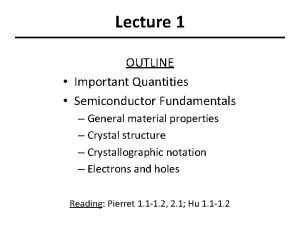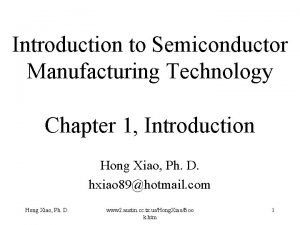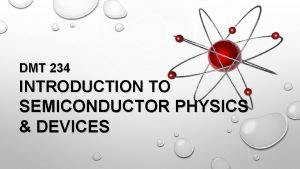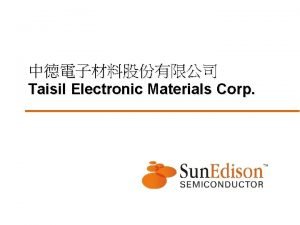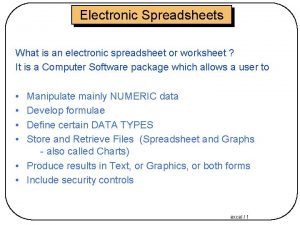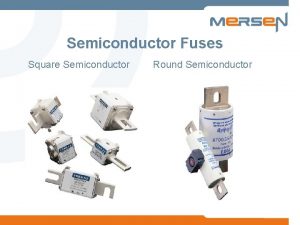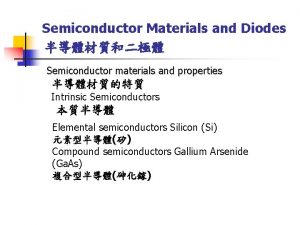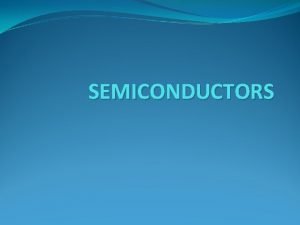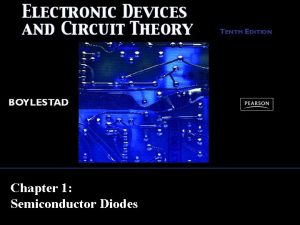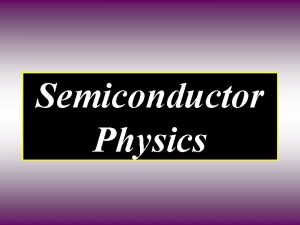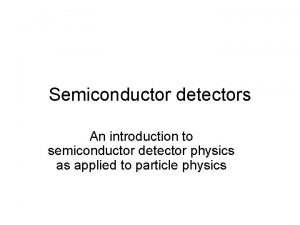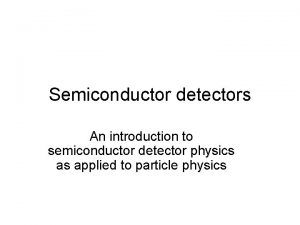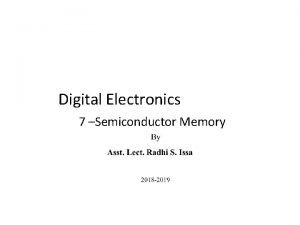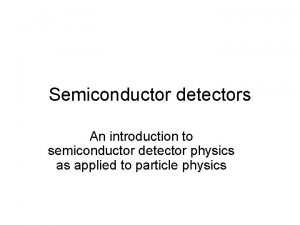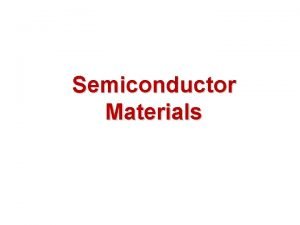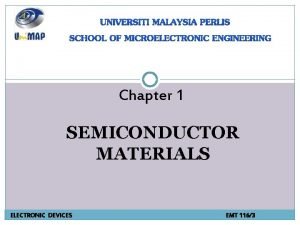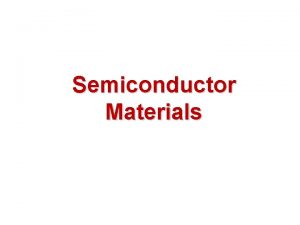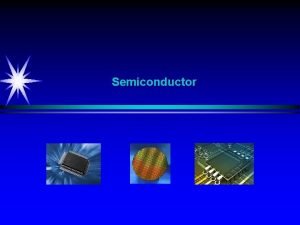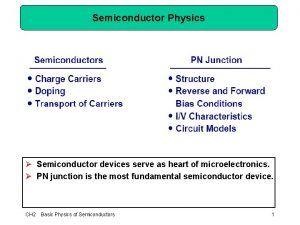Introduction to Semiconductor Materials Electronic Materials The goal

















- Slides: 17

Introduction to Semiconductor Materials

Electronic Materials • • The goal of electronic materials is to generate and control the flow of an electrical current. Electronic materials include: 1. Conductors: have low resistance which allows electrical current flow 2. Insulators: have high resistance which suppresses electrical current flow 3. Semiconductors: can allow or suppress electrical current flow A presentation of e. Syst. org


Insulators • Insulators have a high resistance so current does not flow in them. • Good insulators include: – Glass, ceramic, plastics, & wood • Most insulators are compounds of several elements. • The atoms are tightly bound to one another so electrons are difficult to strip away for current flow. A presentation of e. Syst. org

Semiconductors • Semiconductors are materials that essentially can be conditioned to act as good conductors, or good insulators, or any thing in between. • Common elements such as carbon, silicon, and germanium are semiconductors. • Silicon is the best and most widely used semiconductor. A presentation of e. Syst. org

Semiconductor Valence Orbit • The main characteristic of a semiconductor element is that it has four electrons in its outer or valence orbit. A presentation of e. Syst. org

Crystal Lattice Structure • The unique capability of semiconductor atoms is their ability to link together to form a physical structure called a crystal lattice. • The atoms link together with one another sharing their outer electrons. • These links are called covalent bonds. A presentation of e. Syst. org 2 D Crystal Lattice Structure

3 D Crystal Lattice Structure A presentation of e. Syst. org

Semiconductors can be Insulators • If the material is pure semiconductor material like silicon, the crystal lattice structure forms an excellent insulator since all the atoms are bound to one another and are not free for current flow. • Good insulating semiconductor material is referred to as intrinsic. • Since the outer valence electrons of each atom are tightly bound together with one another, the electrons are difficult to dislodge for current flow. • Silicon in this form is a great insulator. • Semiconductor material is often used as an insulator. A presentation of e. Syst. org

Doping • To make the semiconductor conduct electricity, other atoms called impurities must be added. • “Impurities” are different elements. • This process is called doping. A presentation of e. Syst. org

Semiconductors can be Conductors • An impurity, or element like arsenic, has 5 valence electrons. • Adding arsenic (doping) will allow four of the arsenic valence electrons to bond with the neighboring silicon atoms. • The one electron left over for each arsenic atom becomes available to conduct current flow. A presentation of e. Syst. org

Resistance Effects of Doping • If you use lots of arsenic atoms for doping, there will be lots of extra electrons so the resistance of the material will be low and current will flow freely. • If you use only a few boron atoms, there will be fewer free electrons so the resistance will be high and less current will flow. • By controlling the doping amount, virtually any resistance can be achieved. A presentation of e. Syst. org

Another Way to Dope • You can also dope a semiconductor material with an atom such as boron that has only 3 valence electrons. • The 3 electrons in the outer orbit do form covalent bonds with its neighboring semiconductor atoms as before. But one electron is missing from the bond. • This place where a fourth electron should be is referred to as a hole. • The hole assumes a positive charge so it can attract electrons from some other source. • Holes become a type of current carrier like the electron to support current flow. A presentation of e. Syst. org

Types of Semiconductor Materials • The silicon doped with extra electrons is called an “N type” semiconductor. – “N” is for negative, which is the charge of an electron. • Silicon doped with material missing electrons that produce locations called holes is called “P type” semiconductor. – “P” is for positive, which is the charge of a hole. A presentation of e. Syst. org

Current Flow in N-type Semiconductors • The DC voltage source has a positive terminal that attracts the free electrons in the semiconductor and pulls them away from their atoms leaving the atoms charged positively. • Electrons from the negative terminal of the supply enter the semiconductor material and are attracted by the positive charge of the atoms missing one of their electrons. • Current (electrons) flows from the positive terminal to the negative terminal. A presentation of e. Syst. org

Current Flow in P-type Semiconductors • Electrons from the negative supply terminal are attracted to the positive holes and fill them. • The positive terminal of the supply pulls the electrons from the holes leaving the holes to attract more electrons. • Current (electrons) flows from the negative terminal to the positive terminal. • Inside the semiconductor current flow is actually by the movement of the holes from positive to negative. A presentation of e. Syst. org

In Summary • In its pure state, semiconductor material is an excellent insulator. • The commonly used semiconductor material is silicon. • Semiconductor materials can be doped with other atoms to add or subtract electrons. • An N-type semiconductor material has extra electrons. • A P-type semiconductor material has a shortage of electrons with vacancies called holes. • The heavier the doping, the greater the conductivity or the lower the resistance. • By controlling the doping of silicon the semiconductor material can be made as conductive as desired. A presentation of e. Syst. org
 Semiconductor packaging materials
Semiconductor packaging materials Semiconductor materials
Semiconductor materials Scrip exchange
Scrip exchange Electronic news gathering and electronic field production
Electronic news gathering and electronic field production Introduction to semiconductor manufacturing technology
Introduction to semiconductor manufacturing technology Device physics
Device physics Taisil electronic materials corp
Taisil electronic materials corp What is an electronic spreadsheet?
What is an electronic spreadsheet? Hát kết hợp bộ gõ cơ thể
Hát kết hợp bộ gõ cơ thể Frameset trong html5
Frameset trong html5 Bổ thể
Bổ thể Tỉ lệ cơ thể trẻ em
Tỉ lệ cơ thể trẻ em Gấu đi như thế nào
Gấu đi như thế nào Tư thế worm breton
Tư thế worm breton Chúa yêu trần thế
Chúa yêu trần thế Các môn thể thao bắt đầu bằng từ đua
Các môn thể thao bắt đầu bằng từ đua Thế nào là hệ số cao nhất
Thế nào là hệ số cao nhất Các châu lục và đại dương trên thế giới
Các châu lục và đại dương trên thế giới

